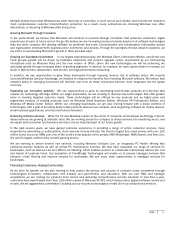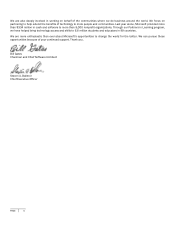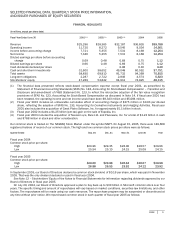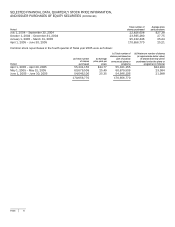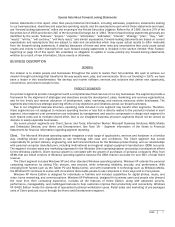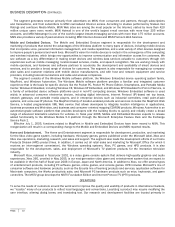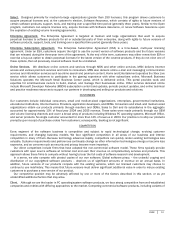Microsoft 2005 Annual Report Download - page 12
Download and view the complete annual report
Please find page 12 of the 2005 Microsoft annual report below. You can navigate through the pages in the report by either clicking on the pages listed below, or by using the keyword search tool below to find specific information within the annual report.
PAGE 11
Redmond, Washington with smaller facilities located in Mountain View, California; Fargo, North Dakota; Beijing, China; Dublin,
Ireland; Vedbaek, Denmark; Hyderabad, India; Haifa, Israel; and Cambridge, England.
We have regional operations centers in Ireland; Singapore; Reno, Nevada; Fargo, North Dakota; and Redmond. The centers
support all operations in their regions, including customer contract and order processing, credit and collections, information
processing and vendor management and logistics. The regional center in Dublin, Ireland, supports the EMEA region; the center
in Singapore supports the Japan, Greater China and Asia-Pacific region; and the centers in Reno, Fargo, and Redmond support
North America and Latin America.
We contract most of our manufacturing activities to third parties. Outside manufacturers produce the Xbox, various retail
software packaged products, and Microsoft hardware. Our products may include some components that are available from only
one or limited sources. Key components that are currently obtained from a single source include the Xbox central processing
unit (CPU) from Intel Corporation and the Xbox graphics processing unit (GPU) from NVIDIA Corporation. Similarly, our upcoming
Xbox 360 console will also include certain key components that will be supplied at least initially by a single source: the CPU
which will be purchased from IBM Corporation and the graphics chips and embedded DRAM chips for the GPU which will be
purchased from TSMC and NEC, respectively. Though we have chosen to initially source these key Xbox 360 components from a
single supplier, we are under no obligation to exclusively source components from these vendors in the future. Beyond the
exceptions noted, we generally have the ability to use other custom manufacturers if the current vendor becomes unavailable.
We generally have multiple sources for raw materials, supplies, and components, and are often able to acquire component
parts and materials on a volume discount basis.
PRODUCT DEVELOPMENT
During fiscal years 2003, 2004, and 2005, research and development expense was $6.60 billion, $7.78 billion, and $6.18
billion respectively. Those amounts represented 20.5%, 21.1%, and 15.5%, respectively, of revenue in each of those years. We
plan to continue significant investment in a broad range of research and product development.
Most of our software products are developed internally. We also purchase technology, license intellectual property rights, and
oversee third-party development and localization of certain products. We believe we are not materially dependent upon licenses
and other agreements with third parties relating to the development of our products. Internal development allows us to maintain
closer technical control over our products. It also gives us the freedom to decide which modifications and enhancements are
most important and when they should be implemented. Product documentation generally is also created internally. We strive to
obtain information at the earliest possible time about changing usage patterns and hardware advances that may affect software
design. Before releasing new software platforms, we provide application vendors with a range of resources and guidelines for
development, training, and testing.
Business and Product Development Strategy. A key factor affecting Microsoft’s growth is innovation. In fiscal year 2005, we
filed for more than 3,000 U.S. patents for new technologies. We continue our long-term commitment to research and
development, including advanced work aimed at important innovations in a wide spectrum of technologies: tools and platform;
communication, collaboration and expression; information access and organization; entertainment; business and e-commerce;
and devices. Through innovations in these areas, we expect to grow revenue via three principal strategies:
• Growing our anchor businesses. The markets for our Client, Server & Tools, and Information Worker businesses are
continuing to grow as a result of growth in hardware shipments and software upgrades. We believe the growth in our
anchor businesses can be accelerated by our forthcoming innovations, including the Windows Vista operating system,
the Office 12 upgrade of the Microsoft Office system, and new products from our Server & Tools business. In addition,
we see opportunities to grow these businesses by making inroads against software piracy. As the world’s emerging
economies develop and integrate more fully into the global economy, we expect that intellectual property will be more
widely and effectively protected, and the current widespread use of unlicensed software will gradually diminish. At the
same time, we are developing new products and services that are specifically designed to appeal to the unique
requirements of emerging markets. Among them are products designed to be readily available and affordable for first-
time PC users. We also expect our anchor businesses to grow through successfully competing against alternative
solutions. In servers, for example, we expect to continue gaining customers as a result of migration from UNIX. We
particularly see opportunities in the markets for Web servers, data centers, e-mail servers and in high-performance
computing.
• Expanding our innovation portfolio. Across each of our businesses, we see opportunities for growth through expansion
of the technologies we offer. Within our anchor businesses, we are working to develop new technologies that offer
greater value in meeting many targeted customer needs: workflow management, real-time communications, document
management, collaboration, terminal services, search and portals, unified messaging, media technologies management,




